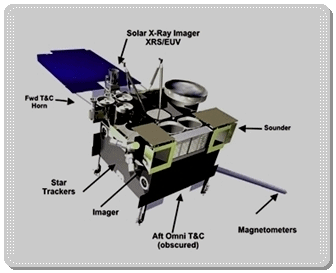
To illustrate a typical weather satellite in orbit around the Earth, we will describe a US GOES satellite. The GOES system is a basic element of U.S. weather monitoring and forecast operations and is a key component of NOAA’s National Weather Service modernization program. Spacecraft and ground-based systems work together to accomplish the GOES mission of providing weather imagery and quantitative sounding data that form a continuous and reliable stream of environmental information for weather forecasting, related services, and the public. GOES (Geostationary Operational Environmental Satellite) missions are geostationary satellites as the series N-P is the next series of satellites, extending the existing GOES system. First GOES launched in 1974. The newer GOES also are able to help relay distress signals from emergency beacons, and are equipped to monitor solar activity. NOAA operates GOES-13 in the east and GOES-11 in the west covering more than 50 percent of the Earth's surface. The GOES-O, which is the specific description we give here, which was renamed GOES-14 once in orbit, launched in June 2009 and parked on a storage orbit whence it can be made operational within 24 hours to replace a older satellite should one of the operational GOES degrade or exhaust their fuel. The GOES satellites operate in geosynchronous orbit 22,236 miles above the Earth and, because their orbital velocity matches the rotation of the Earth, they appear to remain stationary in the sky. A GOES mission costs approximately $499M for the spacecraft, the instrument payload and launch services
 | A View of A GOES Satellite. picture courtesy site 'Amateur Astronomy' based on a picture NASA |
A GOES satellite has dimensions 26 ft (8.2 m)x7 ft 4 in (2.25 m)x11 ft (3.37 m) and a weight in orbit of 4,806 lb (2,180 kg). It features a liquid apogee motor with a thrust of 490 newton (110 lbf) along with 12 bipropellant thrusters with a thrust 9 newton each (12 lbf). A GOES satellite has a three-axis body stabilized Boeing 601 heritage design in terms of attitude control as the control is provided through a stellar inertial based control system that employs a set of three star trackers and a Hemispherical Inertial Reference Unit (HIRU) to monitor and compute the spacecraft’s attitude. Four reaction wheels are used to control the spacecraft in the normal mode as 12 2-lb. thrusters are used to manage momentum and to maintain the orbital location. A GOES solar panel consist into 1 wing panel made of dual-junction gallium arsenide solar cells which power 24-cell nickel-hydrogen 123 amp/hr batteries. In terms of communications, a GOES satellite is equipped with the following antennas and horns: 2 S/L-band, cup-shaped dipole, 1 L-band, cup-shaped dipole, 1 UHF, cup-shaped dipole, 1 omni antenna, 1 L-band horn, and 1 S-band horn. The command data rate is of 2,000 bps and the telemetry rate of either 4,000 or 1,000 bps. The satellite has a design lifetime is of 10 years, with the propellant lifetime increased now to 14 years
In satellites used for communications, global positioning systems, and defense purposes, a heat pipe is the device used to regulate temperature and keep the overall systems operating reliably. A heat pipe is a simple device that can, in the absence of convection in micro-gravity, efficiently transfer heat from a hot spot to a cooler remote location without the use of a mechanical pump. A heat pipe is usually a sealed tube in which all the air is removed and a small amount of liquid is introduced under a partial vacuum. A portion of the liquid in contact with a system hot surface evaporates into a vapor as it absorbs heat from the hot surface. The vapor condenses back to a liquid when the vapor comes in contact with the pipe cool surface, thus releasing its stored or latent heat. The liquid then draws back toward the hot surface, due to the interaction of the individual liquid molecules and their attraction to the surface of the container, a process called capillary action. The whole liquid and vapor cycle requires no moving parts and the heat transfer process can repeat indefinitely
A Earth-orbiting satellite, generally, is fueled with liquid ethanol as the fuel valves are triple-sealed during the satellite's construction
Each GOES satellite features two major instruments, a Imager and a Sounder as it carries also the Space Environment Monitor suite which includes the Solar X-ray Imager, several charged particle detection instruments, and x-ray and extreme ultraviolet sensors as the series also bears a 406MHz emergency beacon with a Search and Rescue Transponder. A GOES satellite generally is now a more stable platform for supporting its improved weather and science instruments. A dedicated transponder supports the Emergency Manager's Weather Information Network (EMWIN) service
As far as the NASA-NOAA partnership is concerned, NASA in 1983 signed an agreement with the NOAA, the US weather service, to design and build the GOES program. NOAA manages the overall GOES Program and establishes requirements, provides funding, distributes environmental data for the U.S., and determines the need for satellite replacement. NASA teams with NOAA to acquire and manage the study, design and development of each of the GOES spacecraft. NASA’s Goddard Space Flight Center (GSFC) in Greenbelt, Md., is responsible for the construction, integration and verification testing of the spacecraft, instruments and unique ground equipment. NOAA and NASA collaborate together to the dissemination of data acquired by GOES satellites
Website Manager: G. Guichard, site 'Amateur Astronomy,' http://stars5.6te.net. Page Editor: G. Guichard. last edited: 2/17/2011. contact us at ggwebsites@outlook.com